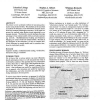Free Online Productivity Tools
i2Speak
i2Symbol
i2OCR
iTex2Img
iWeb2Print
iWeb2Shot
i2Type
iPdf2Split
iPdf2Merge
i2Bopomofo
i2Arabic
i2Style
i2Image
i2PDF
iLatex2Rtf
Sci2ools
CHI
1996
ACM
1996
ACM
Structuring Information with Mental Models: A Tour of Boston
We present a new systematic method of structuring information using mental models. This method can be used both to evaluate the efficiency of an information structure and to build user-centered information structures. In this paper we present the method using Boston tourist attractions as an example domain. We describe several interfaces that take advantage of our mental models with an activation spreading network. Multidimensional Scaling and Trajectory Mapping are used to build our mental models. Because of the robustness of the technique, it is easy to compare individual difference in mental models and to customize interfaces for individual models. Keywords Cognitive models, multidimensional scaling, visualization, interaction design, evaluation.
CHI 1996 | Human Computer Interaction | Information Structures | Mental Models | Multidimensional Scaling |
| Added | 08 Aug 2010 |
| Updated | 08 Aug 2010 |
| Type | Conference |
| Year | 1996 |
| Where | CHI |
| Authors | Ishantha Lokuge, Stephen A. Gilbert, Whitman Richards |
Comments (0)

